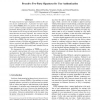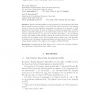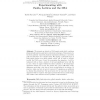10 search results - page 1 / 2 » Two-Party Generation of DSA Signatures |
CRYPTO
2001
Springer
15 years 5 months ago
2001
Springer
d Abstract) Philip MacKenzie and Michael K. Reiter Bell Labs, Lucent Technologies, Murray Hill, NJ, USA We describe a means of sharing the DSA signature function, so that two parti...
120
click to vote
NDSS
2003
IEEE
15 years 6 months ago
2003
IEEE
We study proactive two-party signature schemes in the context of user authentication. A proactive two-party signature scheme (P2SS) allows two partiesāthe client and the serverā...
114
click to vote
DCC
2003
IEEE
16 years 7 days ago
2003
IEEE
Nguyen and Shparlinski recently presented a polynomial-time algorithm that provably recovers the signer's secret DSA key when a few bits of the random nonces k (used at each s...
PKC
2005
Springer
15 years 6 months ago
2005
Springer
We present an attack on DSA smart-cards which combines physical fault injection and lattice reduction techniques. This seems to be the ļ¬rst (publicly reported) physical experimen...
117
Voted
JOC
2002
15 years 9 days ago
2002
We present a polynomial-time algorithm that provably recovers the signer's secret DSA key when a few bits of the random nonces k (used at each signature generation) are known ...



